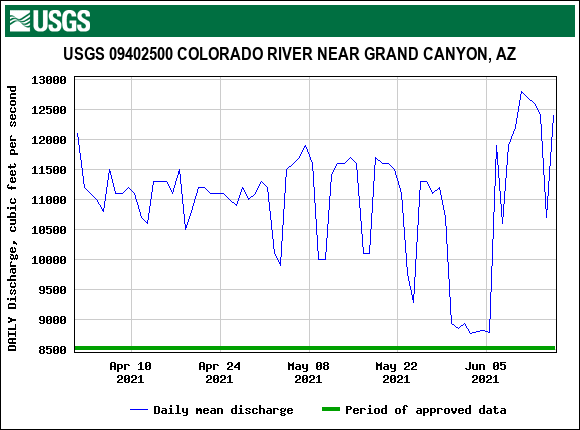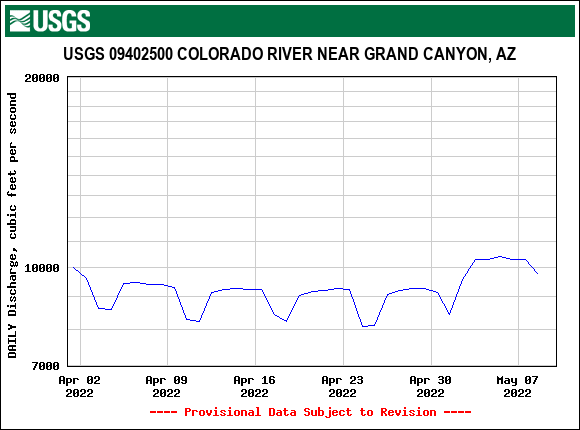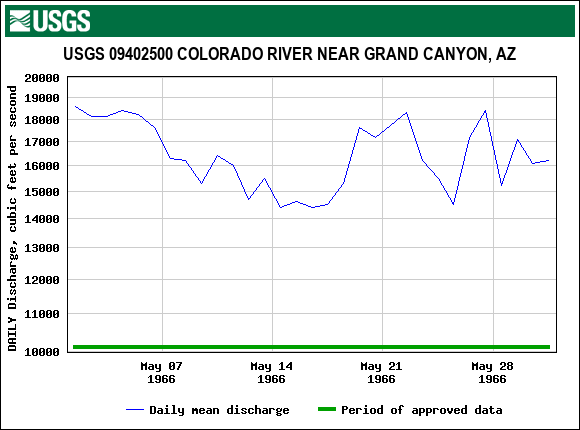Topic
Crossing the Colorado in the Grand Canyon
Forum Posting
A Membership is required to post in the forums. Login or become a member to post in the member forums!
Home › Forums › Campfire › Trip Planning › Crossing the Colorado in the Grand Canyon
- This topic has 8 replies, 6 voices, and was last updated 2 years, 9 months ago by
 Rex Sanders.
Rex Sanders.
-
AuthorPosts
-
May 6, 2022 at 12:40 am #3748570
What do you think is the minimum kit required to (safely) cross the Colorado in the Grand Canyon? No rapids involved, just wanting to get from one side to the other, maybe with a very small amount of downstream travel. I’m in the beginning stages of thinking about a possible solo trip in the autumn, and hoping I wouldn’t have to shell out for a fancy packraft. Thanks!
May 6, 2022 at 4:56 am #3748573I would not recommend trying to swim across the Colorado River in the Grand Canyon – anywhere.
Many miles of the river look slow and lazy from a distance. The reality is that the currents can be swift, eddies can catch you but not release you easily, eddy fences (where upstream and downstream currents meet) can be tough to cross, and corkscrew currents can suck swimmers under.
Hydropower releases from Glen Canyon Dam upstream means it also depends on the time of day, which changes as the “tides” move downstream at roughly 3 mph. Plus the water is very cold year-round, mostly coming from the bottom of a reservoir.
Your best bet might be to hitch a ride from a passing private boat trip. Even better if you bring your own PFD (lifejacket), which you would absolutely want in any self-powered river crossing anyway. I have more suggestions if you decide to try that.
I’m a former whitewater raft guide who took a boat down the Canyon a couple of times, worked on two research trips studying eddy currents and sandbars along the river, and spent weeks analyzing the Glen Canyon Dam operations environmental impact report in the 1990s. But I never tried to cross without a pretty big boat.
Maybe someone on BPL has done this and can add their perspective.
— Rex
May 6, 2022 at 5:51 pm #3748616Thanks a lot, Rex. Swimming never sounded like a good idea based on the number of drownings I’d heard about, but I also hadn’t understood what the specific dangers were (as you say, the river looks so well-behaved!). So this info is very helpful.
I’ve heard snippets about people crossing using basic inflatables like you can get for a few $$ off Amazon through to ‘proper’ packrafts, but I haven’t seen a good explanation of what works and what doesn’t, and why. If you or anyone else has thoughts about (or ideally, experience with) that, that would be great.
May 6, 2022 at 6:59 pm #3748618I’m not Michael Phelps. You’re probably not, either. I figure a recreational swimmer swims at 1 mph (and even less with a PFD or backpack on). The seemingly lazy circulation of some large eddy may actually being moving at a walking pace which you can never achieve while swimming.
I’ve got a minimal (in size and weight and cost) pack raft that’s still pretty robust that I use to lighter from a motor boat (that last trip ashore, while leaving the boat anchored in deeper water): klymit.com/products/litewater-dinghy but you’d also need a double-bladed paddle and some skill in the reading the currents to follow a good line and get across before the calmer stretch moves into the next canyon restriction.
I’ve crossed the Colorado lots of times each day we were on the River in a 16-foot oar boat or 14-foot paddle boat (with 5 paddlers).
The other 20 times I’ve crossed the Colorado was on either of the two suspension bridges along the main trail corridors between the South Kaibab / Bright Angel Trails and the North Kaibab Trail on the other side. My equipment was always low-cut hiking shoes, shorts and a t-shirt, but it could be done quite safety while naked IF you have enough sunscreen on.
May 6, 2022 at 7:41 pm #3748624A friend just finished the Hayduke, they hitched a ride across with some rafters. Waited at a good looking spot where rafters frequently stop. The guides were happy to help.
May 7, 2022 at 9:47 am #3748666A river guide there some years ago drowned while using a pool toy type inflatable. He had prob been drinking at the time but he made a bad decision. The story may be in Tom Myers’ ‘Death in Grand Canyon’ book..not sure.
May 8, 2022 at 12:18 am #3748709You want significant whitewater experience in a packraft to cross the Colorado River through the Grand Canyon.
If you don’t know what you are doing, eddy fences can be hard to cross without flipping. On much smaller rivers, I’ve seen many kayaks flip there. In one extreme case, I watched a 14-foot raft flip on an eddy fence, and one person drowned.
You might see small flotillas of inflatable kayaks with people from commercial river trips. Experienced river guides keep a close eye on them, know which parts of the river are safer, and they mostly stay in the main current.
Hitch a ride. Even in the fall, you shouldn’t have to wait more than a few hours. Enjoy the peace of the river for a while, knowing you’ll get across much safer.
Safest of all: cross on a bridge.
— Rex
May 9, 2022 at 1:12 pm #3748839Check out Colin Fletcher’s “The man who walked through time” or any edition of his “the Complete Walker” for plenty of detail on how he accomplished solo crossings of the Colorado in the Grand Canyon.
geoffrey
May 9, 2022 at 8:17 pm #3748904Colin Fletcher backpacked the length of Grand Canyon National Park in “early April” 1963, with a two-month plan.
Here are the daily river flows just above Phantom Ranch for April, May, and early June of 1963:

Here are the same flows in 2021, and to date in 2022:


From The New Complete Walker
Because of the new Glen Canyon Dam, a hundred miles upriver, the Colorado was then running at only 1200 cubic feet per second – far below its normal low-water level.
He also describes swimming across the Colorado River four times on a trip in May 1966, wearing an inflatable life vest while clinging to a framed backpack prepared for extra buoyancy.

Each time I could have landed within a half-mile of my launch site …
Fletcher vividly describes being swept through a rapid on one crossing. Scared me, and I’ve swam plenty of rapids while knowing what I’m doing. It took him a “full mile” to get to the other shore.
Plus the river was much warmer in those years. In 1963 he said the river temperature was around 60° F and about 57° F in 1966. I found contemporary river temperatures for Lees Ferry, upstream near Glen Canyon Dam. The river barely warms up over the next 225 miles.

The yellow line is the average over the last 25 years. Considerably colder than Fletcher’s swims.
At one point he speculates that a group of hikers could send a strong swimmer with a rope across first, then pull the others across. “At least, I guess so.”
DON’T without training. People have died from being tied to ropes, or getting tangled in ropes, while swimming in swift rivers.
Again: Hitch a ride, or cross a bridge.
Sorry to be a downer, but I gained a healthy respect for whitewater after taking hundreds of people safely down dozens of rivers over 20+ years. And deliberately swimming or falling in many times, always wearing a high-flotation whitewater PFD. And often a wetsuit or a drysuit, because the water was so dang cold.
— Rex
-
AuthorPosts
- You must be logged in to reply to this topic.
Forum Posting
A Membership is required to post in the forums. Login or become a member to post in the member forums!
Our Community Posts are Moderated
Backpacking Light community posts are moderated and here to foster helpful and positive discussions about lightweight backpacking. Please be mindful of our values and boundaries and review our Community Guidelines prior to posting.
Get the Newsletter
Gear Research & Discovery Tools
- Browse our curated Gear Shop
- See the latest Gear Deals and Sales
- Our Recommendations
- Search for Gear on Sale with the Gear Finder
- Used Gear Swap
- Member Gear Reviews and BPL Gear Review Articles
- Browse by Gear Type or Brand.








